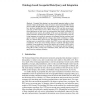GISCIENCE
2008
Springer
14 years 1 months ago
2008
Springer
GISCIENCE
2008
Springer
14 years 1 months ago
2008
Springer
A trajectory is the time-stamped path of a moving entity through space. Given a set of trajectories, this paper proposes new conceptual definitions for a spatio-temporal pattern n...
GISCIENCE
2008
Springer
14 years 1 months ago
2008
Springer
Road networks, roads, and junctions are examples of natural language terms whose semantics can be described by affordances of their physical referents. In order to define affordanc...
GISCIENCE
2008
Springer
14 years 1 months ago
2008
Springer
Dynamic geographic phenomena, such as forest fires and oil spills, can have dire environmental, sociopolitical, and economic consequences. Mitigating, if not preventing such events...
GISCIENCE
2008
Springer
14 years 1 months ago
2008
Springer
GISCIENCE
2008
Springer
14 years 1 months ago
2008
Springer
Abstract. New methods of data collection, in particular the wide range of sensors and sensor networks that are being constructed, with the ability to collect real-time data streams...
GISCIENCE
2008
Springer
14 years 1 months ago
2008
Springer
Geospatial data sharing is an increasingly important subject as large amount of data is produced by variety of sources, stored in incompatible formats, and accessible through diffe...
GISCIENCE
2008
Springer
14 years 1 months ago
2008
Springer
Movement patterns, like flocking and converging, leading and following, are examples of high-level process knowledge derived from lowlevel trajectory data. Conventional techniques...
GISCIENCE
2008
Springer
14 years 1 months ago
2008
Springer
Abstract. This paper presents an automatic approach to mining collections of maps from the Web. Our method harvests images from the Web and then classifies them as maps or non-map...
GISCIENCE
2008
Springer
14 years 1 months ago
2008
Springer
Topological relations are sometimes insufficient for differentiating spatial configurations of two objects with critical difference in their connection styles. In this paper, we pr...




